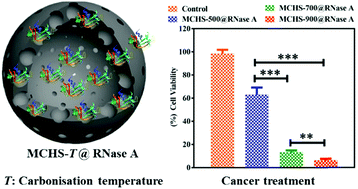Mesoporous carbon hollow spheres: carbonisation-temperature-dependent delivery of therapeutic proteins†
Abstract
Protein therapeutics have received significant recognition due to their potential in the treatment of diseases and cancer, thanks to the rapid development of efficient nanocarriers. In this work, we for the first time report the influence of the carbonisation temperature of mesoporous carbon hollow spheres (MCHS) on their delivery performance of therapeutic proteins. Samples MHCS-500, MHCS-700 and MHCS-900 were prepared at carbonisation temperatures of 500, 700 and 900 °C, respectively. It was found that MHCS-900 displayed the highest inherent hydrophobicity among all samples. As a result, MHCS-900 demonstrated the highest loading amount and most sustained release of RNase A (a therapeutic protein). The hydrophobicity also facilitated the cellular uptake and endo/lysosome escape of RNase A delivered by MHCS-900. Consequently, RNase A delivered by MHCS-900 significantly improved the therapeutic efficacy tested in human squamous carcinoma cells (SCC25) compared with free RNase A or those delivered by the other MHCS carriers. This work optimises the carbonisation temperature on porous carbon spheres for highly efficient intracellular delivery of therapeutic proteins.



 Please wait while we load your content...
Please wait while we load your content...